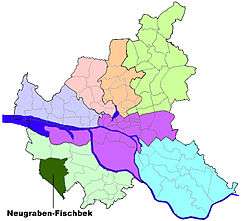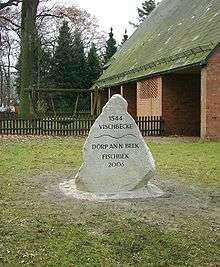Neugraben-Fischbek
![]()
Neugraben-Fischbek | |
|---|---|
Quarter of Hamburg | |
Location of Neugraben-Fischbek in Hamburg  | |
 Neugraben-Fischbek  Neugraben-Fischbek | |
| Coordinates: 53°29′0″N 9°52′0″E | |
| Country | Germany |
| State | Hamburg |
| City | Hamburg |
| Borough | Harburg, Hamburg |
| Area | |
| • Total | 22.5 km2 (8.7 sq mi) |
| Population (31-12-2016) | |
| • Total | 28,991 |
| • Density | 1,300/km2 (3,300/sq mi) |
| Time zone | CET/CEST (UTC+1/+2) |
| Dialling codes | 040 |
| Vehicle registration | HH |
History

History of Fischbek
Fischbek was first mentioned in 1544 as Vischbecke. In 1937 the independent village Fischbek was merged into Hamburg.[1]
History of Neugraben

In 1937 the independent village of Neugraben was merged into Hamburg.[1]
Subcamp Neugraben
In Neugraben was a subcamp of the Nazi concentration camp Neuengamme.[2] On September 13, 1944 the women subcamp was opened in Falkenbergweg. 500 Czech-Jewish women coming from the Ghetto Theresienstadt were deported to the Auschwitz concentration camp. The SS in Auschwitz selected the women for labour in Hamburg. In the Neugraben camp the work was building auxiliary homes, also laying supply pipes and building streets in the neighbourhood Falkenbergsiedlung. During the last months of World War II, some of the women had to do clearing up work in Harburg's oil industry and to dig antitank obstacles in Hamburg-Hausbruch. In February 1945, the SS transferred the women to the camp Hamburg-Tiefstack and later from there to the Bergen-Belsen concentration camp.[3]
Geography
Neugraben-Fischbek is southeast of the quarter Neuenfelde, in the northeast is Francop, in the east is the quarter Hausbruch. In the south is the district Harburg of the German state Lower Saxony. A large part of the quarter is the nature reserve Harburger Berge (Hills of Harburg) in the south. Neugraben-Fischbek it a mixed rural and suburban area of 22.5 km².
In Neugraben-Fischbek is the highest rise of Hamburg, the Hasselbrack, which reaches 116.2 metres AMSL[4]
Demographics
In 2006 in the Neugraben-Fischbek quarter were living 27,103 people. The population density was 1,204/km2 (3,118/sq mi). 19% were children under the age of 18, and 21.4% were 65 years of age or older. Resident aliens were 10.1% of the population. 1,644 people were registered as unemployed.[5]
In 1999 there were 12,170 households out of which 27.9% had children under the age of 18 living with them and 30.5% of all households were made up of individuals. The average household size was 2.31.[6]
Population by year[5]
| 1987 | 1988 | 1989 | 1990 | 1991 | 1992 | 1993 | 1994 | 1995 | 1996 | 1997 | 1998 | 1999 |
| 25,603 | 25,794 | 26,228 | 26,384 | 26,505 | 26,643 | 26,643 | 27,415 | 27,381 | 27,630 | 27,589 | 27,657 | 27,753 |
| 2000 | 2001 | 2002 | 2003 | 2004 | 2005 | 2006 |
| 27,685 | 27,601 | 27,453 | 27,599 | 27,377 | 27,218 | 27,103 |
Infrastructure
Transportation
Neugraben-Fischbek is served by the rapid transit system of the city train with the stations Neugraben and Fischbek.[7]
See also
Notes
- Greater Hamburg Act
- The camp is listed as No. 560 Hamburg-Neugraben in the official German list of concentration camps.
- Memorial Neuengamme (in German)
- Geologisches Landesamt Hamburg (State office of geological affairs of Hamburg)
- Residents registration office, source: statistical office of Hamburg and Schleswig-Holstein (2006)
- Source: statistical office of Hamburg and Schleswig-Holstein (1999)
- Staff (2009-10-09), Rapid Transit/Regional Rail (Network plan, pdf) (PDF), Hamburger Verkehrsverbund, archived from the original (PDF) on 2009-01-17, retrieved 2009-02-07
References
- Statistical office Hamburg and Schleswig-Holstein Statistisches Amt für Hamburg und Schleswig-Holstein, official website (in German)
- Official German list of concentration camps Verzeichnis der Konzentrationslager und ihrer Außenkommandos gemäß § 42 Abs. 2 BEG (in German)
Parts translated from de:Neugraben-Fischbek
External links
| Wikimedia Commons has media related to Hamburg-Neugraben-Fischbek. |
- Neugraben-Hausbruch Notgeld (emergency currency) webgerman.com/Notgeld/Directory/N/Neugraben.htm